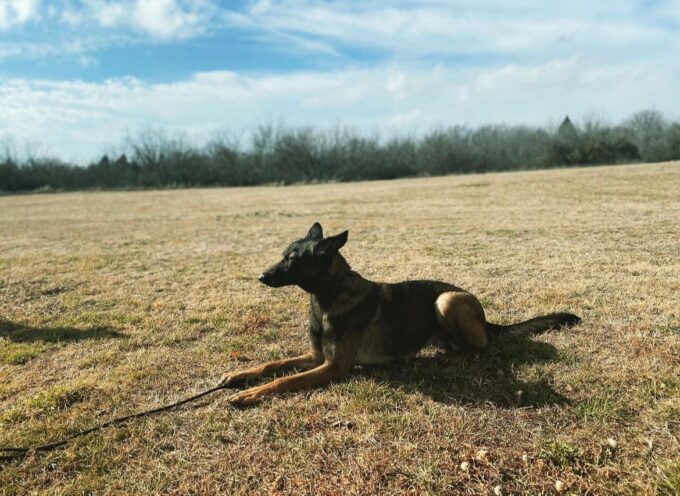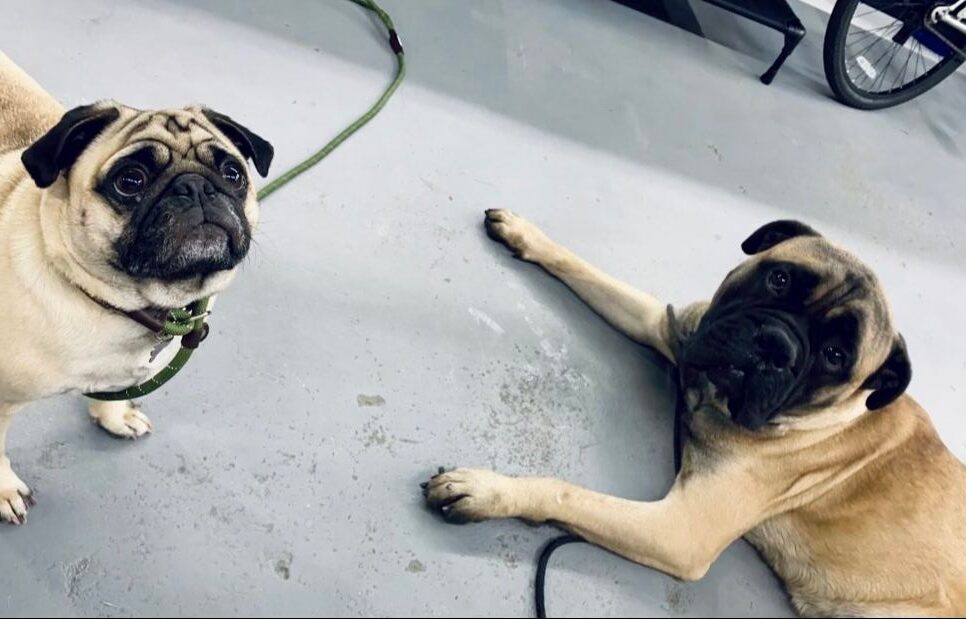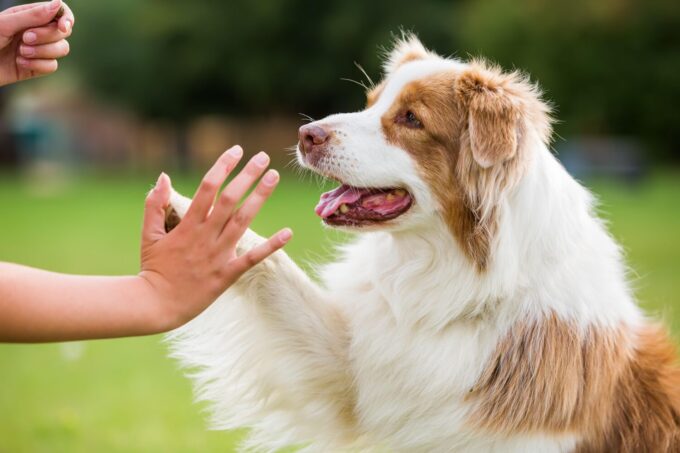Leash training is important for dogs of all ages, including older dogs. It allows you to walk comfortably with your well-behaved dog and ensures their safety. To successfully leash train an older dog, gather all the necessary materials such as a leash, treats, water bottle, and collar.
Start by desensitizing your dog to wearing a leash indoors and reward them for calm behavior. Use rewards and praises to reinforce good habits and be patient throughout the training process. Avoid punishment-based training techniques and choose the right type of leash for your dog.
Before starting leash training, make sure your dog is fit and healthy. Finally, consider wearing reflective gear for evening walks and keep your dog’s ID tags updated for safety. If, after reviewing the topics in this article, you decide you don’t have time to train your dog,you can reach out to this dog training company here and talk to them.

Contents
Key Takeaways
- Leash training is important for older dogs to ensure their safety and improve walking behavior.
- Gather all the necessary materials, including a leash, treats, water bottle, and collar, before starting the training.
- Desensitize your dog to wearing a leash indoors to make them comfortable with the sensation.
- Reward good behavior with treats and praises to reinforce positive habits during leash training.
- Be patient and consistent throughout the training process and avoid punishment-based techniques.
Gather and Assess Materials for Leash Training an Older Dog
Before you start leash training an older dog, it is important to gather all the necessary materials. Having the right tools on hand will ensure a smooth and successful training process. Here are the essential items you’ll need:
- A leash: Choose one that is larger and thicker to accommodate the size and strength of an older dog. Consider high-quality leather leashes for durability.
- Treats: Use tasty treats as rewards to motivate and reinforce good behavior during training.
- Water bottle: Carry a water bottle to keep your dog hydrated during training sessions, especially if they are longer walks.
- Collar: Ensure your dog has a properly fitted collar that is comfortable and secure.
By gathering these materials, you’ll be well-prepared to begin leash training your older dog.
Having the right tools on hand will ensure a smooth and successful training process.
Table: Materials for Leash Training an Older Dog
| Item | Description |
| Leash | Larger and thicker leash for older dogs |
| Treats | Tasty treats as rewards for good behavior |
| Water Bottle | To keep your dog hydrated during training |
| Collar | Properly fitted collar for comfort and security |
With these materials at hand, you’ll be ready to embark on a successful leash training journey with your older dog.
Desensitize Your Dog to Wearing a Leash
If your older dog is not used to wearing a leash, it is important to desensitize them before starting proper leash training. This process involves gradually introducing and familiarizing them with the sensation of wearing a leash. By taking small steps and being consistent, you can help your dog overcome any initial discomfort or fear associated with wearing a leash.
Start by attaching the leash to your dog’s collar while they are indoors. Allow them to wear it for short periods of time, gradually increasing the duration as they become more comfortable. During this process, observe your dog’s behavior and body language. If they show signs of distress or discomfort, take a step back and give them more time to adjust.
As they grow accustomed to wearing the leash, reward them with treats and verbal praise for remaining calm and relaxed. This positive reinforcement will help create a positive association with wearing the leash. Remember to be patient and give your dog plenty of encouragement throughout the desensitization process.
Benefits of Desensitizing Your Dog to Wearing a Leash

- Reduces anxiety and stress
- Promotes a positive attitude towards leash training
- Helps your dog feel more comfortable and secure
- Creates a foundation for successful leash training
Desensitization Tips
- Start indoors in a calm, familiar environment
- Use high value treats to reward calm behavior
- Gradually increase the duration of leash wearing sessions
- Observe and respond to your dog’s body language
- Consistency and patience are key
| Common Signs of Discomfort | How to Respond |
| Pacing or whining | Remove the leash and give your dog a break, then try again later |
| Trying to bite or scratch the leash | Redirect their attention with a toy or treat, and praise when they focus on the toy or treat rather than the leash |
| Avoiding or hiding from the leash | Introduce the leash gradually, allowing your dog to approach it at their own pace |
Reward and Praise Good Habits
When leash training an older dog, it is crucial to reward and praise good habits. Dogs respond well to positive reinforcement, and it helps motivate them to continue exhibiting the desired behavior. Most dogs are motivated by food, so using treats can be an effective way to encourage good behavior during leash training.
For example, when your dog returns calmly to your side or walks calmly without pulling on the leash, reward them with a treat and praise. This positive reinforcement helps them associate good behavior with rewards, making them more likely to repeat it in the future. Remember to be consistent with your rewards and praise to reinforce the desired habits.
As your dog progresses in their training, you can gradually reduce the frequency of treats and rely more on verbal praise. Verbal praise, such as saying “good dog” or “well done,” can be given in conjunction with treats or on its own. The key is to show your dog that their good behavior is appreciated and valued.
Benefits of Reward and Praise
- Creates a positive association with leash training
- Motivates dogs to continue exhibiting good behavior
- Strengthens the bond between you and your dog
- Increases your dog’s confidence and trust
- Helps reinforce positive habits and discourage negative ones
Rewarding and praising your dog for good leash behavior is an important part of their training. It helps them understand what you expect from them and encourages them to repeat the desired actions. Remember to be consistent and patient throughout the training process.
By focusing on positive reinforcement through rewards and praise, you can effectively leash train your older dog and foster a strong and healthy bond between you and your furry companion. Keep in mind that every dog is unique, so it may take time and patience to find the rewards and praise that work best for your dog.
| Reward and Praise Techniques | Benefits |
| Using treats to reward good behavior | Immediate positive reinforcement |
| Verbal praise and petting | Shows appreciation and increases bond |
| Combining treats and verbal praise | Reinforces good behavior and strengthens association |
Use Patience in Leash Training Older Dogs

Leash training for older dogs requires patience and understanding. It’s important to remember that these dogs may have ingrained behaviors that take time to change. Rushing the training process can lead to frustration for both you and your furry companion. Instead, embrace a patient and positive approach to ensure effective leash training.
When working with an older dog, it’s essential to be consistent in your training methods. Repetition and reinforcement of good behaviors will help your dog understand what is expected of them on the leash. Avoid using punishment-based techniques, such as choke chains or shock collars, as these can cause fear and distress. Instead, focus on positive reinforcement through treats, praises, and rewards.
Older dogs may require more time to adapt to leash training compared to younger dogs. They may have physical limitations or past experiences that affect their progress. Be mindful of your dog’s pace and provide them with plenty of encouragement and support. Celebrate even the smallest achievements and remember that every step forward is a success.
Benefits of Patience in Leash Training Older Dogs
Patient leash training is not only beneficial for your dog, but it also strengthens the bond between you and your furry friend. By taking the time to understand their needs and working at their pace, you build trust and create a positive training environment. Patience reduces stress for both you and your dog, making the training sessions more enjoyable and effective.
Remember, every dog is unique, and progress may vary. Stay patient and consistent, and you will see gradual improvements over time. Leash training an older dog is a journey that requires dedication and understanding. Embrace the process with patience, and you will reap the rewards of a well-behaved and happy dog.
Choose the Right Leash for Leash Training
When it comes to leash training your older dog, choosing the right leash is essential for successful and effective training sessions. The type of leash you use can greatly impact your dog’s behavior and overall training experience. Here are some key factors to consider when selecting the perfect leash for leash training:
Type of Leash
There are various types of leashes available, so it’s important to choose one that is suitable for your older dog. A training leash, such as a figure of 8 lead, can be an excellent choice. This type of leash helps promote better leash manners by keeping your dog by your side during walks. It provides more control and makes it easier to correct any unwanted behavior exhibited by your dog.
Length and Thickness
The length and thickness of the leash are also important considerations. For older dogs, opt for a longer leash that allows them more freedom to explore while still maintaining control. Additionally, a thicker leash is recommended to accommodate the size and strength of your older dog. A thicker leash will provide durability and prevent any accidental breaks or snaps during training sessions.
Material
The material of the leash is another crucial factor to consider. While leather leashes are known for their durability, they may not be suitable for all dogs. Some dogs are prone to chewing or pulling on the leash, so choosing a material that is more resistant to such behavior may be a better option. Additionally, consider a leash with a comfortable handle grip to ensure a secure and comfortable grip during walks.
| Type of Leash | Length | Thickness |
| Training Leash (Figure of 8 lead) | Longer for freedom | Thicker for strength |
| Material | Leather or resistant material | Comfortable handle grip |
By considering these factors and choosing the right leash for leash training, you’ll set yourself and your older dog up for success. Remember, the leash is not just a means of control, but a tool to facilitate a positive and enjoyable walking experience for both you and your furry companion.
Consider Your Dog’s Health

Source: countrylife.co.uk
When embarking on leash training for your older dog, it is important to consider their health and well-being. Before starting any training program, it is essential to ensure that your dog is fit and healthy enough to handle the physical demands of leash training. This is especially important for older dogs, as they may have underlying health issues or injuries that could be exacerbated by strenuous exercise.
To prioritize your dog’s health, it is recommended to visit a veterinarian before initiating leash training. Your vet will be able to assess your dog’s overall health status and provide guidance on any precautions or modifications that may be necessary. They can also address any specific concerns you may have regarding your dog’s fitness level or potential limitations.
By considering your dog’s health before starting leash training, you can provide them with a safe and comfortable training experience. This proactive approach will help prevent any potential harm or discomfort during the training process and ensure that your dog’s well-being remains the top priority.
| Benefits of Considering Your Dog’s Health | How to Implement It |
| Prevent exacerbation of underlying health issues | Consult with a veterinarian before starting leash training |
| Avoid discomfort or injury during training | Follow any recommendations or modifications provided by the veterinarian |
| Ensure a safe and comfortable training experience | Monitor your dog’s health throughout the training process |
Considering your dog’s health is crucial for successful leash training. By taking the necessary precautions and seeking professional advice, you can ensure that your older dog remains healthy and happy throughout the training process.
Conclusion
Leash training an older dog is a crucial step towards ensuring their safety and well-being. By following these tips and techniques, you can successfully train your older dog to walk on a leash. Start by gathering all the necessary materials such as a leash, treats, water bottle, and collar. These items will help you establish a smooth training routine and prevent any setbacks.
Remember to desensitize your dog to wearing a leash indoors before starting proper leash training. This process will help your dog become calmer and more receptive to the training process. Reward and praise your dog for good behavior during leash training sessions. Positive reinforcement will help them associate the desired behavior with rewards, making the training process more effective.
Be patient throughout the training process, as older dogs may take more time to break old habits and learn new ones. Avoid punishment-based methods and choose the right leash type to promote better leash manners.
Finally, consider your dog’s health before starting leash training. If your dog has any underlying health issues or injuries, consult a veterinarian to ensure their well-being during training. With consistency, positive reinforcement, and patience, you can successfully leash train your older dog and enjoy safe and enjoyable walks together.
FAQ
Is leash training important for older dogs?
Yes, leash training is important for dogs of all ages, including older dogs. It allows you to walk comfortably with your well-behaved dog and ensures their safety.
What materials do I need for leash training an older dog?
Gather all the necessary materials such as a leash, treats, water bottle, and collar.
How do I desensitize my older dog to wearing a leash?
Start by clipping and unclipping the leash on the dog indoors for a few minutes each day to get them accustomed to the sensation.
How can I reward and praise my older dog during leash training?
Use treats and verbal praise to reward and reinforce good behavior, such as returning calmly to your side or walking calmly on the leash.
Why is patience important when leash training older dogs?
Older dogs may have deeply ingrained behaviors, so it is important to remain patient and consistent throughout the training process.
What type of leash should I choose for leash training?
Choose a leash that is suited for training, such as a figure of 8 lead, which helps keep your dog by your side and promotes better leash manners.
Should I consider my older dog’s health before leash training?
Yes, it is important to ensure your dog is fit and healthy before engaging in leash training, especially if they have underlying health issues or injuries.


